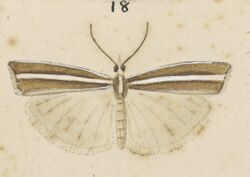Biology:Orocrambus dicrenellus
From HandWiki
Short description: Species of moth
| Orocrambus dicrenellus | |
|---|---|

| |
| Illustration of female | |
| Scientific classification | |
| Domain: | Eukaryota |
| Kingdom: | Animalia |
| Phylum: | Arthropoda |
| Class: | Insecta |
| Order: | Lepidoptera |
| Family: | Crambidae |
| Subfamily: | Crambinae |
| Tribe: | Crambini |
| Genus: | Orocrambus |
| Species: | O. dicrenellus
|
| Binomial name | |
| Orocrambus dicrenellus (Meyrick, 1882)[1]
| |
| Synonyms | |
| |
Orocrambus dicrenellus is a moth in the family Crambidae.[2] This species was first described by Edward Meyrick in 1882 under the name Crambus dicrenellus.[1][3] It is endemic to New Zealand.[4] It has been recorded from the central part of the South Island.
Taxonomy
O. dicrenellus was first described by Edward Meyrick in June 1882 and named Crambus dicrenellus.[5] Meyrick gave a fuller description of this species in May of 1883.[6] The male lectotype specimen, collected at Mount Hutt by R. E. Fereday, is held at the Natural History Museum, London.[7]
Description
The wingspan is 29–33 mm. Adults have been recorded on wing from November to February.[8]
References
- ↑ 1.0 1.1 Beccaloni, G.; Scoble, M.; Kitching, I. et al., eds (2003). "Orocrambus dicrenellus". The Global Lepidoptera Names Index. Natural History Museum. https://www.nhm.ac.uk/our-science/data/lepindex/detail/?taxonno=6388.
- ↑ , p. 457, Wikidata Q45922947
- ↑ Meyrick, E. (1882). "Descriptions of New Zealand Microlepidoptera." (in en). New Zealand Journal of Science 1: 186–187. https://biodiversitylibrary.org/page/41865810. Retrieved 21 January 2018.
- ↑ "Orocrambus dicrenellus (Meyrick, 1883)". Landcare Research New Zealand Ltd. http://www.nzor.org.nz/names/e8de4d9a-b5f1-46b9-b889-4ca5fa769aa5.
- ↑ , pp. 187, Wikidata Q115108516
- ↑ , pp. 22-23, Wikidata Q111013914
- ↑ , pp. 147, Wikidata Q45083134
- ↑ Gaskin, D. E. (1975). "Revision of the New Zealand Crambini (Lepidoptera: Pyralidae: Crambinae)". New Zealand Journal of Zoology 2 (3): 265–363. doi:10.1080/03014223.1975.9517878.
Wikidata ☰ Q13965308 entry
 |

